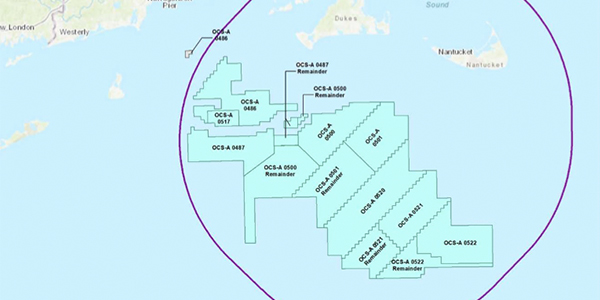The Massachusetts Department of Energy Resources (DOER) said last week it will not require the state’s electric distribution companies to solicit proposals for a coordinated independent transmission network for the 1,600 MW of offshore wind energy already procured, but recommended bundling transmission in its next OSW solicitation.
“Following a thorough investigation, DOER finds that the costs and risks of a solicitation for independent offshore wind energy transmission outweigh the potential benefits that could be captured by 1,600 MW of transmission capacity,” Commissioner Patrick Woodcock said in a letter to the legislature’s Joint Committee on Telecommunications, Utilities and Energy. DOER said it feared the solicitation could delay upcoming OSW generation procurements and complicate contracting and permitting issues.

The purple line marks the cables and pipelines geographic analysis area for the Vineyard Wind project. | BOEM
Instead, the agency is recommending a bundled solicitation of 1,600 MW of generation and transmission, which it said could reduce cabling and use onshore interconnection points efficiently. The state — which has selected Mayflower Wind and Vineyard Wind 1 to build the first 1,600 MW of offshore wind in federal leasing areas south of Martha’s Vineyard — initially planned two additional 800-MW procurements.
DOER said that a larger solicitation for bids up to the full 1,600 MW currently authorized would allow developers greater flexibility in project design. First, a larger solicitation would allow developers the option of using HVDC cables, which can transmit up to 1,400 MW on a single cable versus 400 MW for HVAC cables, for offshore wind, the agency said. Second, a larger solicitation would allow developers the option to interconnect onshore at the maximum capacity allowed by ISO-NE (1,200-MW single contingency limit), which could help ensure that the limited number of onshore interconnection points in Massachusetts is used to maximum potential.
“In sum, a larger solicitation would give developers maximum flexibility to use transmission infrastructure efficiently, thereby helping ensure … bids that minimize the environmental and socioeconomic impacts of siting offshore wind structures in the ocean and on land and achieve many of the potential benefits of the independent transmission solicitation without the added costs and risks,” DOER said.
DOER also said it would consider joining with neighboring states on a backbone transmission plan.
A network transmission “initiative could be achieved more effectively at a larger scale of offshore wind build-out and with regional coordination among New England states … than through a single state procurement with limited size,” Woodcock said.
Comments in Favor

Massachusetts hosted a technical conference in March to explore whether it should solicit proposals for a transmission network for offshore wind generation. (See Mass. DOER Explores Transmission for OSW.) The planning choice was between generators developing the transmission — the generator lead line, or radial system — and independent transmission construction and ownership, or a network system.
The DOER letter noted significant stakeholder support for a networked or backbone-independent transmission approach at a larger capacity.
Included in a second round of stakeholder comments published April 22, State Rep. Patricia Haddad, speaker pro tempore of the Massachusetts House of Representatives, said in a letter to DOER that “we have been successful with the two recent offshore wind bids with generator lead lines. I feel the next procurement should include crucial shared transmission opportunities.”
The Responsible Offshore Development Association (RODA), a fishing industry group, submitted a letter urging independent transmission development if it would mean using less cable and having fewer environmental impacts.
Upping the Target
Meanwhile, the Massachusetts House amended its climate change bill Friday to increase the amount of offshore wind energy the state and utilities must contract from 3,200 MW to 3,600 MW. It also would cut the time between procurements from 24 months to 18 months.
Earlier last week, the Senate amended its economic development bill to mandate procurement of an additional 2,800 MW of OSW by 2035, which would raise total authorization to 6 GW.
The two houses will have to reconcile their differences in conference committee.


